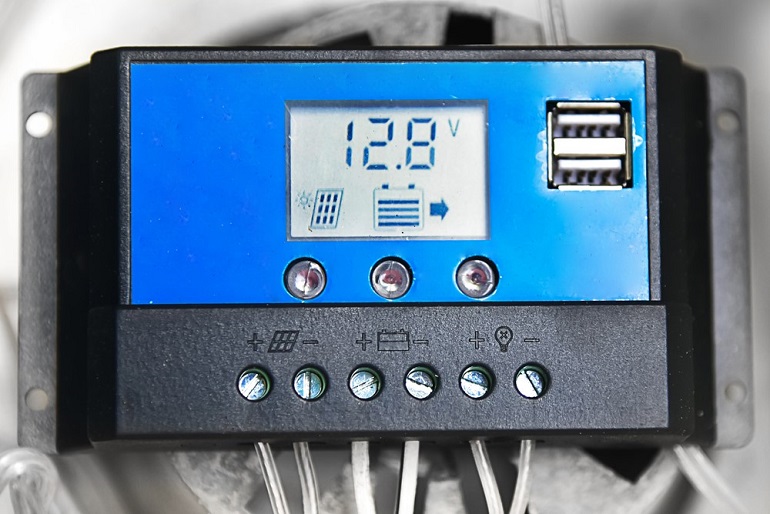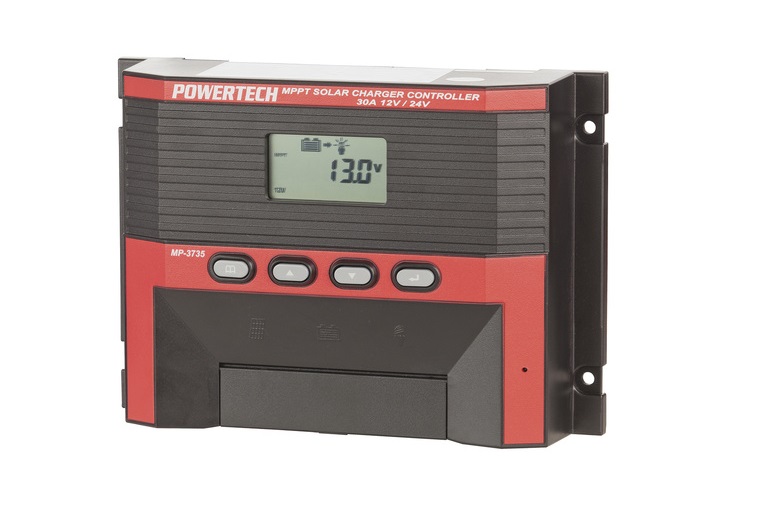Solar charge controllers, also known as regulators, are battery chargers connected between the battery and solar panels. Their purpose is to regulate the charging process of the battery to prevent overcharging. DC coupled charge controllers have been around for many years and are used in almost every small scale off-grid solar system. Modern charge controllers have advanced features to make sure the battery is charged efficiently and precisely. They’re rated based on the maximum charge current (A) and input voltage (V). These ratings determine how many solar panels can be attached to the system. The charge current (A) refers to the maximum input and charging current, whereas the maximum voltage refers to the maximum voltage of the panels.

There are two basic types of solar charge controllers – MPPT and PWM. MPPT charge controllers are the most advanced type, which is why I’ll be focusing on them. MPPT, also known as maximum power point tracking controllers, allow the solar panels to operate at the optimum voltage for maximum output. These charge controllers utilise clever technologies that make them 30% more efficient than PMW controllers. MPPT controllers should be used in high power systems that are made up of 2 or more solar panels, or whenever the panel voltage is higher than the battery voltage.
MPPT charge controllers are efficient DC to DC converters that were invented by the Australian company AERL in 1985. Their method of operation is pretty simple – due to the difference in sunlight landing on solar panels throughout the day, the voltage and current continuously shift. In order to get the most out of it, MPPT sweeps through the voltage to find the best combination of current and voltage to produce maximum power. MPPT charge controllers are designed to track and adjust the voltage to generate the most power, regardless of the weather conditions and time of day.

Unlike inverters, charge controllers can be used with a variety of battery voltages. For instance, most smaller controllers can be used to charge either 12V or 24V batteries, whereas higher capacity/voltage charge controllers can be used on 24V or 48V batteries. Some charge controllers can be used for all battery voltages. Charge controllers are also rated in amps. You can find a 40A 12V charge controller online, which would be suitable for a 520W solar array. A 40A solar charge controller with 24V batteries, on the other hand, would be suitable for a 1040W solar array.
That being said, you’ll have to size the solar charge controller properly, by determining the appliances or loads you’ll be running and the amount of time you’ll be running them for. This is done by calculating the power rating of the appliance and multiplying the rating by the runtime. Alternatively, you can use the current draw and multiply it by the runtime. The amount of Ah or Wh you get will be used to size the battery. Lithium-ion batteries are sized in either Ah or Wh, whereas lead-acid batteries are sized in Ah.
As a general rule of thumb, the controller amp rating should be 10-20% of the battery amp-hour rating. For instance, a 200Ah lead-acid battery will require a 20A to 40A solar charge controller, and a 300W or larger solar panel to generate the 20A charge current necessary for the battery to reach the absorption voltage. If the amp rating of the controller is too small, the charge current will be too low for the battery, reducing its lifespan. The size of the current being used to charge the battery is determined by the number and size of solar panels, the time of day and year, and panel orientation. Keep in mind that various losses can occur, adding up to 20% wattage loss. For instance, a 300W solar panel can produce from 240W to 280W in full sun, due to loss factors such as dust, reflection, conversion loss, cell temperature de-rating, etc.
As aforementioned, charge controllers are rated according to the maximum charge current and voltage. The maximum voltage determines how many panels you can attach and the current rating determines the maximum charge current and the suitable battery size that can be charged. The solar panel should be able to generate close to the charge current of the controller, which should match the battery. So for instance, a 200Ah 12V battery will require a minimum 20A 12V charge controller online and a 250W solar panel. But due to the various loss factors, most solar panels don’t operate at their maximum rated power, which is why you should look to implement a 300W panel or two 150W panels. The total solar panel array power is determined by the voltage multiplied by the charge current. A higher battery voltage means you can connect more solar panels using the same charge current.

